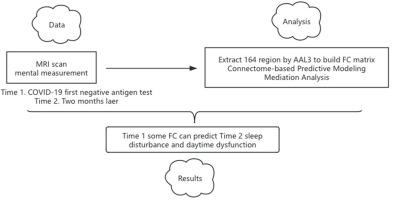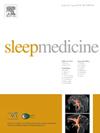Resting-state functional connectome predicts sleep quality two months after the first negative COVID-19 antigen test
IF 3.4
2区 医学
Q1 CLINICAL NEUROLOGY
引用次数: 0
Abstract
Background
The COVID-19 pandemic has led to long-term neurological and psychological effects, including sleep disturbances. While prior studies have identified altered brain function post-COVID-19, specific functional connectivity (FC) patterns predicting sleep quality after recovery remain unclear. This study aims to identify FC patterns associated with sleep quality two months after the first negative COVID-19 antigen test.
Methods
Using a connectome-based predictive modeling (CPM) approach, we identified the functional connectome regulating sleep quality based on a 164-region parcellation. Significant connections were analyzed using mediation models to examine their role in the relationship between anxiety, depression, and sleep.
Results
FC between the right cerebellar peduncle and the left VIII of the cerebellum, and between the left middle temporal pole (MTP) and left ventral tegmental area (VTA), significantly predicted Pittsburgh Sleep Quality Index (PSQI) scores for sleep disturbances two months post-recovery (q2 = 0.059, MSE = 0.154, p = 0.017, r = 0.350). Mediation analysis showed a significant indirect effect of FC between the left MTP and VTA on the relationship between generalized anxiety and sleep disturbances (indirect effect = 0.013, 95% CI = [0.002, 0.03], pfdr <0.05). FC between the right dorsal raphe nucleus and ipsilateral regions—including occipital, parietal, and temporal areas—predicted PSQI scores for daytime dysfunction (q2 = 0.092, MSE = 0.678, p = 0.025, r = 0.342).
Conclusion
Post-COVID-19 brain connectivity and anxiety predict sleep quality. These findings highlight the potential for targeted therapeutic strategies to improve sleep and identify patients at risk for prolonged disturbances through FC biomarkers.

静息态功能连接组预测首次 COVID-19 抗原检测阴性两个月后的睡眠质量。
背景:COVID-19 大流行导致了长期的神经和心理影响,包括睡眠障碍。虽然之前的研究已经发现了 COVID-19 后大脑功能的改变,但预测恢复后睡眠质量的特定功能连接(FC)模式仍不清楚。本研究旨在确定 COVID-19 抗原检测首次呈阴性两个月后与睡眠质量相关的 FC 模式:方法:利用基于连接组的预测建模(CPM)方法,我们根据 164 个区域的划分确定了调节睡眠质量的功能连接组。我们使用中介模型分析了重要的连接,以研究它们在焦虑、抑郁和睡眠之间的关系中的作用:结果:右侧小脑脚和左侧小脑第八节之间的FC,以及左侧中颞极(MTP)和左侧腹侧被盖区(VTA)之间的FC,显著预测康复后两个月的匹兹堡睡眠质量指数(PSQI)得分(q2 = 0.059,MSE = 0.154,p = 0.017,r = 0.350)。中介分析表明,左侧 MTP 和 VTA 之间的 FC 对广泛焦虑和睡眠障碍之间的关系有明显的间接影响(间接影响 = 0.013,95% CI = [0.002,0.03],pfdr 2 = 0.092,MSE = 0.678,p = 0.025,r = 0.342):结论:COVID-19 后大脑连通性和焦虑可预测睡眠质量。这些发现凸显了有针对性的治疗策略的潜力,以改善睡眠,并通过 FC 生物标记物识别有长期睡眠障碍风险的患者。
本文章由计算机程序翻译,如有差异,请以英文原文为准。
求助全文
约1分钟内获得全文
求助全文
来源期刊

Sleep medicine
医学-临床神经学
CiteScore
8.40
自引率
6.20%
发文量
1060
审稿时长
49 days
期刊介绍:
Sleep Medicine aims to be a journal no one involved in clinical sleep medicine can do without.
A journal primarily focussing on the human aspects of sleep, integrating the various disciplines that are involved in sleep medicine: neurology, clinical neurophysiology, internal medicine (particularly pulmonology and cardiology), psychology, psychiatry, sleep technology, pediatrics, neurosurgery, otorhinolaryngology, and dentistry.
The journal publishes the following types of articles: Reviews (also intended as a way to bridge the gap between basic sleep research and clinical relevance); Original Research Articles; Full-length articles; Brief communications; Controversies; Case reports; Letters to the Editor; Journal search and commentaries; Book reviews; Meeting announcements; Listing of relevant organisations plus web sites.
 求助内容:
求助内容: 应助结果提醒方式:
应助结果提醒方式:


